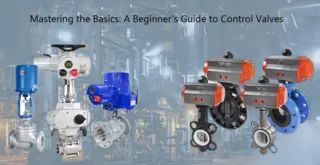


A Comprehensive Guide to Control Valves: Fundamentals, Applications, and Pros & Cons
Control valves are ubiquitous in industrial environments, yet their complex roles often go underappreciated. This guide explores the essentials of China control valves—what they are, how they work, their applications, common types, and their advantages and disadvantages.
A control valve is a mechanical device designed to regulate the flow, pressure, or temperature of a fluid within a system. It functions by varying the size of the flow passage through the valve in response to commands from a process controller. Through this modulation, control valves maintain process variables within specified limits, ensuring that systems operate efficiently, safely, and reliably.
Control valves work by altering the flow resistance within a pipeline or process system. The valve position is adjusted—either opening wider or closing tighter—to control the amount of fluid passing through. This movement is achieved by an actuator, which receives a signal from a controller (typically pneumatic, electric, or hydraulic). The actuator translates these signals into mechanical motion, adjusting the valve plug, disc, or other closure elements to modulate flow in real time according to system demands.
Control valves have wide-ranging applications across numerous industries, including:
Oil and Gas: Regulating the flow and pressure of hydrocarbons during extraction, refining, and transport.
Chemical Processing: Precise control of reactant flows and pressures for optimized reactions and safety.
Power Generation: Managing steam flow, feedwater, and cooling fluids for efficient plant operation.
Water Treatment: Controlling chemical dosing and water flow to ensure proper treatment levels.
HVAC Systems: Regulating air and fluid flow for heating, cooling, and ventilation efficiency.
From steam regulation in power plants to fluid mixing in chemical refineries, control valves are essential to process control and optimization.
Control valves vary by design and application, with common types including:
Globe Valves: Known for their precise throttling ability, globe valves are excellent for applications requiring fine flow control.
Butterfly Valves: Featuring a rotating disc, butterfly valves handle large flows with low pressure drop and simplified maintenance.
Ball Valves: Utilize a rotating ball with a central hole, offering fast, reliable on/off control rather than modulation.
Diaphragm Valves: Use a flexible diaphragm to control flow, ideal for corrosive or sterile fluid handling.
Each valve type is selected based on the specific process requirements, including flow rate, pressure, fluid characteristics, and maintenance considerations.
Advantages:
Enable precise, automated control over critical process variables.
Offer operational flexibility and can be integrated with modern control systems.
Improve safety and efficiency by maintaining stable process conditions.
Compatible with a wide range of fluids and operating environments.
Disadvantages:
Mechanical components are subject to wear, potentially leading to leakage or failure.
Maintenance and repair can be complex and require skilled personnel.
Incorrect valve selection or installation may cause inefficiency or process instability.
Some valve types may not be suitable for highly abrasive or corrosive media without special materials.
A solid understanding of control valves—their function, types, applications, and strengths and limitations—is crucial for engineers, technicians, and plant operators. Mastering these fundamentals enables informed decisions on valve selection, integration, and maintenance, ultimately optimizing system performance and reliability. As industrial automation advances, the role of control valves remains central to achieving operational excellence across diverse sectors.Know more about Google SEO Directory
